The world is an interesting place with many known and unknown bugs. Some of them are easy to identify based on their common nature.
Some of the weirdest bugs in the world come with spines, transparent wings, or peculiar habits which makes them weird, but still intriguing.
The following selection of species shows just how interesting wildlife can get around the world. Some of these bugs don’t even look like bugs at all, as they mimic objects, plants, or even other species.
Table of Contents
1. Man-faced Stink Bug
Stink bugs normally come in a uniform or lightly patterned appearance. The Man-faced Stink Bug (Catacanthus incarnatus) is different and even named after its face-looking appearance.
This type of bug is found in Madagascar and in Asia, where it is considered a dangerous pest of cashew.
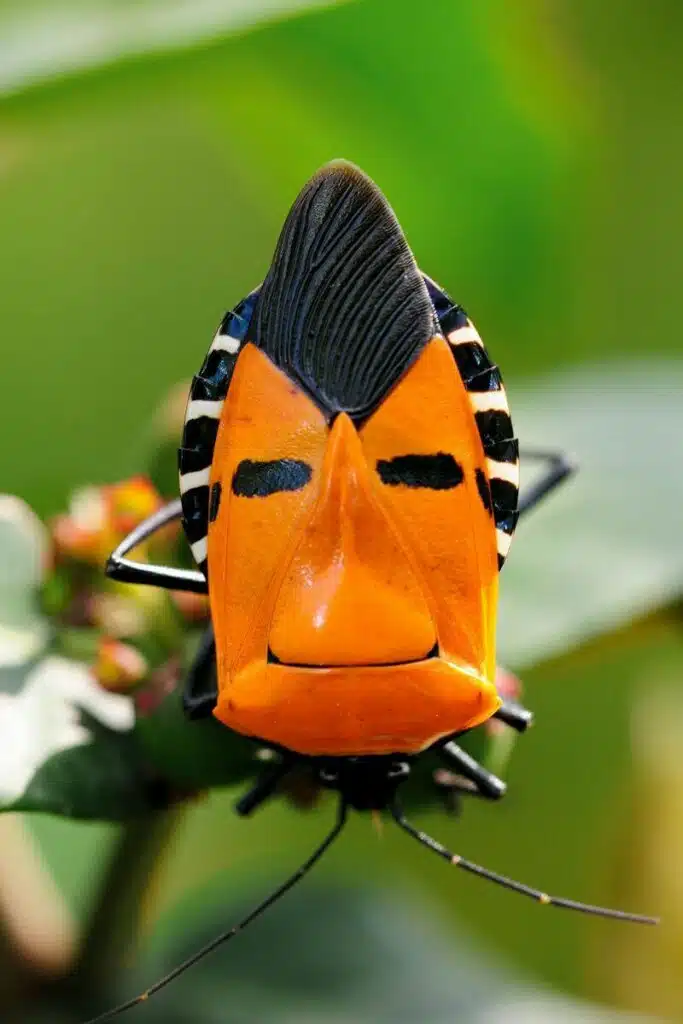
The stink bug has the same shield shape as most other stink bugs. However, its orange or orange-red elytra shows 4 black spots or 2 black spots that resemble the eyes of humans and a short projection that resembles a human nose.
While the species looks weird, it is also feared as it destroys cashew, together with other types of plants, flowers, and even trees.
Man-faced Stink Bugs can be detected early when it comes to good management. Its nymphs are mostly bright green and can be removed by hand before they cause too much damage.
2. Brazilian Treehopper

The Brazilian Treehopper (Bocydium globulare) is one of the most bizarre bugs in the world. It features appendices above its head that may be light brown, dark brown, or even black.
Apart from these appendices, there’s even a long antennae-like projection that runs along its body.
The appendices of these bugs are round-shaped. They have an irregular positioning above their head or thorax and may serve different purposes, such as making the bug look like something else to predators.
As with many types of bizarre bugs, the diet of this species can also be problematic.
While young, The Brazilian Treehopper sucks plant sap directly from young leaves.
Too many of these treehoppers on a host plant can mean its death is close.
3. Golden Egg Bug
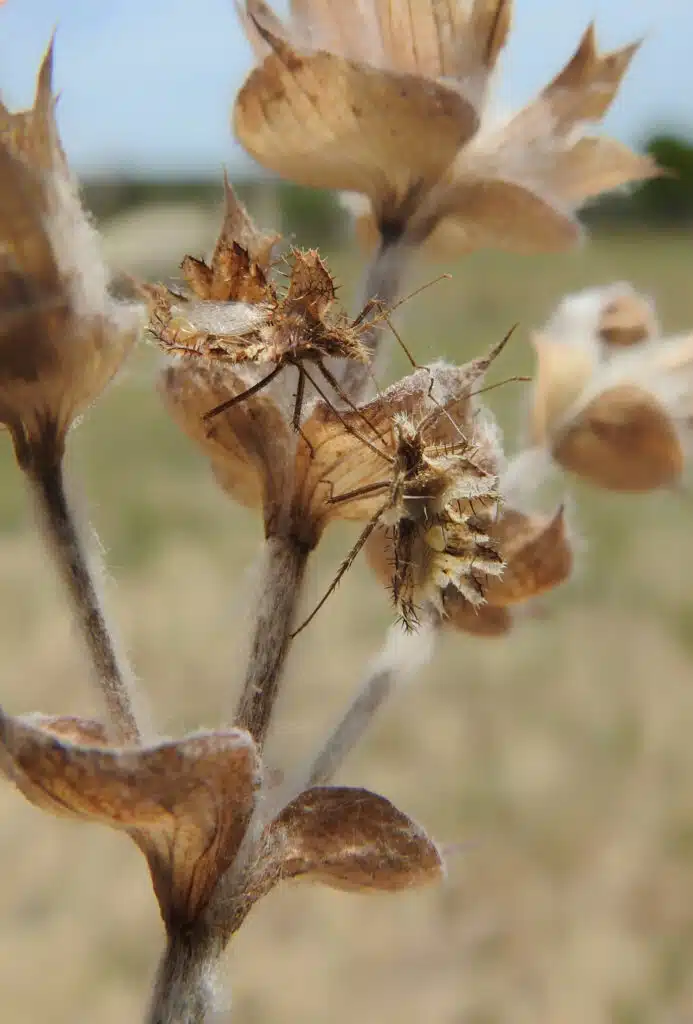
Living in sandy areas due to their aridity-loving host plants, Golden Egg Bugs (Phyllomorpha laciniata) are some of the weirdest bugs in the world.
From some angles, they don’t even look like bugs at all. They have a leaf-like shape with multiple thin projections that look like erect spines or thick hairs.
Even the legs of Golden Egg Bugs are weird, almost looking like small twigs.
The weirdness of the species doesn’t stop here as these bugs also lay atypical eggs.
The eggs of Golden Egg Bugs are actually golden. They have a golden-yellow appearance which makes them stand out and look almost like no other bug egg at all.
4. Whip Spider
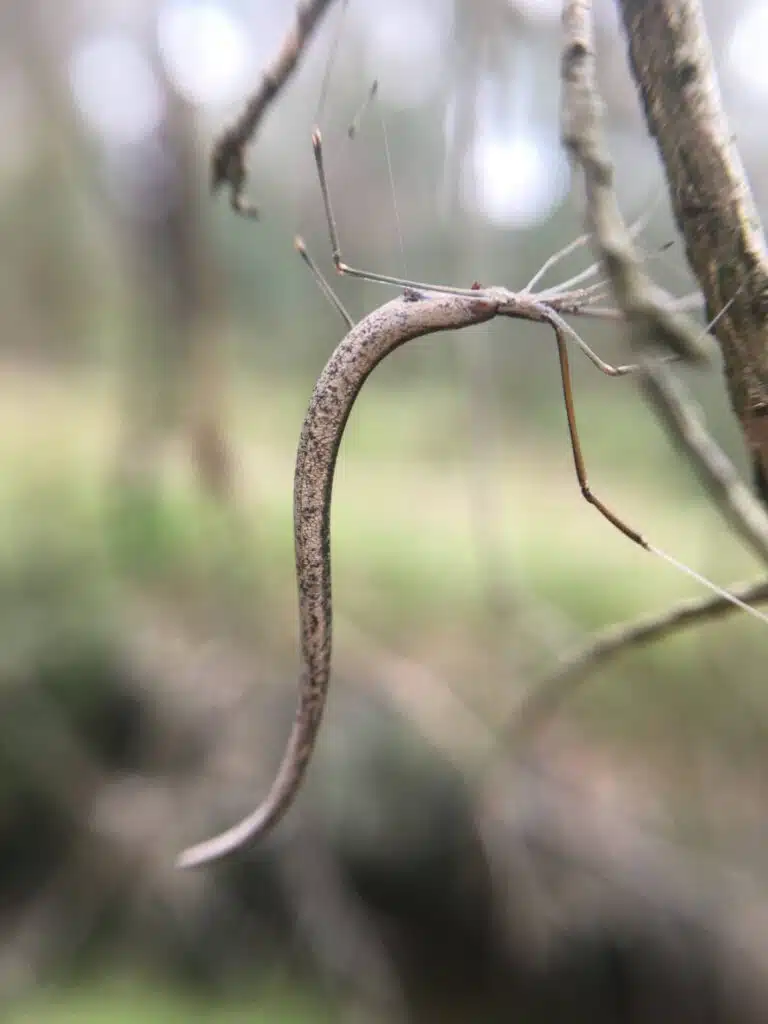
With long whip-like legs, Whip Spiders (Ariamnes colubrinus) are some of the weirdest bugs in the world.
They are weird in many ways, including their flattened shape which also makes them some of the thinnest large bugs in the world.
Their pedipalps are also distinct, as they are used to grab insects.
However, some of their legs aren’t actually legs or whips, for that matter. They are actually sensorial projections used to detect the surfaces in front of the bug.
The front legs of the species are packed with a tactical feel so that the bug can safely navigate its way around.
5. Scorpion-tailed Spider
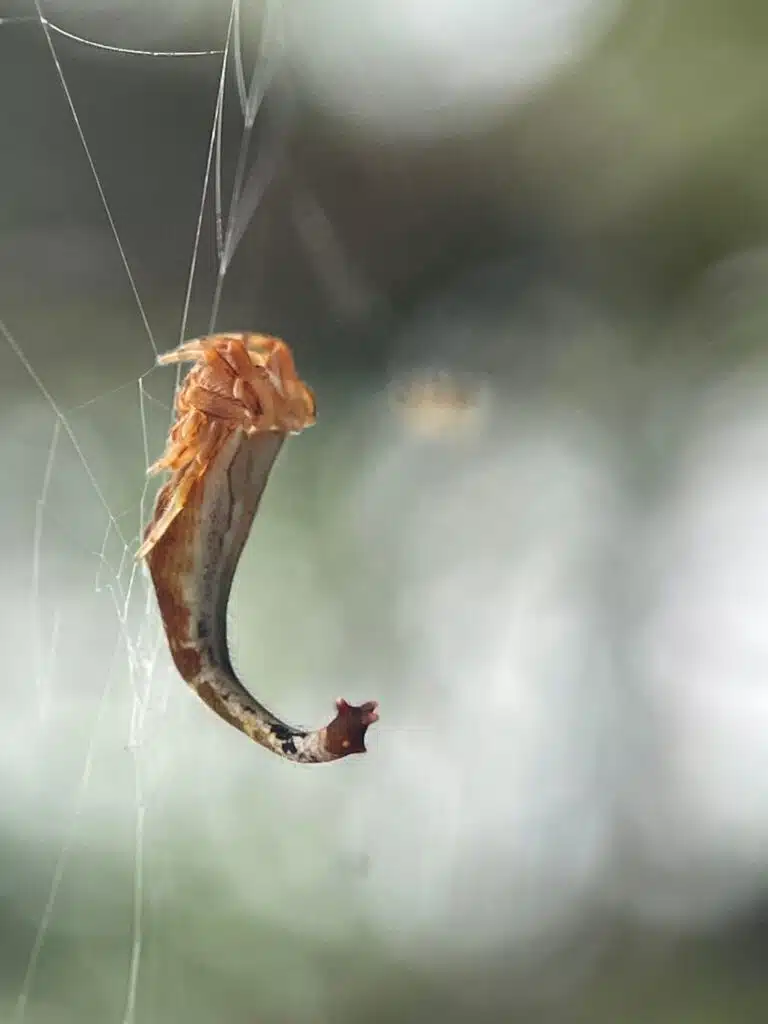
A species of Australia and Asia, The Scorpion-tailed Spider (Arachnura higginsi) is among the most atypical spiders in the world.
This is a species that builds a spider web, and rests on it, but may not be immediately identified as a spider or a bug.
It has an elongated body with a long pointy tail similar to the long tails of scorpions.
From some angles, this brown and yellow spider may even look like a dying curled leaf. Its appearance serves to its advantage as this spider has some of the weirdest predators as well.
It grows to a maximum length of just over 1 inch, with many Scorpion-tailed Spiders being even smaller than 0.5 inches.
6. Peacock Spiders

As some of the weirdest groups of spiders in the world, Peacock Spiders (genus Maratus) are also found in Australia.
These are some of the most colorful spiders in the world, often being confused with other bugs.
They come in all colors and even vivid colors such as pink, red, and bright purple.
Mostly known for their multicolored abdomens, Peacock Spiders are also weird or atypical in behavior.
Take breeding behavior as an example. Did you know Peacock Spiders can flap their colorful abdomens forward?
This helps create small vibrations which scientists believe attract potential female partners.
If this technique doesn’t work, Peacock Spiders can even move sideways in dance-like movements, all to gain the approval of the female spider for breeding.
7. Ant-mimicking Spiders

Ant-mimicking Spiders (genus Myrmarachne) are named after their ant mimicry appearance. These types of spiders can pass as very large ants.
While not the only spiders in the world to look like ants, Ant-mimicking Spiders are among the spiders that mimic both the look and the habits of ants, such as their movement patterns.
Spiders of this family also show a sculpted body, with an almost thread-like waist with a thick abdomen and cephalothorax.
The positioning of their legs also resembles the positioning of ant legs.
Colors are dark when it comes to full chromatic mimicry. These colors are mostly dominated by black nuances, but gray and brown sections are also common, just like in different species of ants.
8. Hawaiian Happy-face Spider
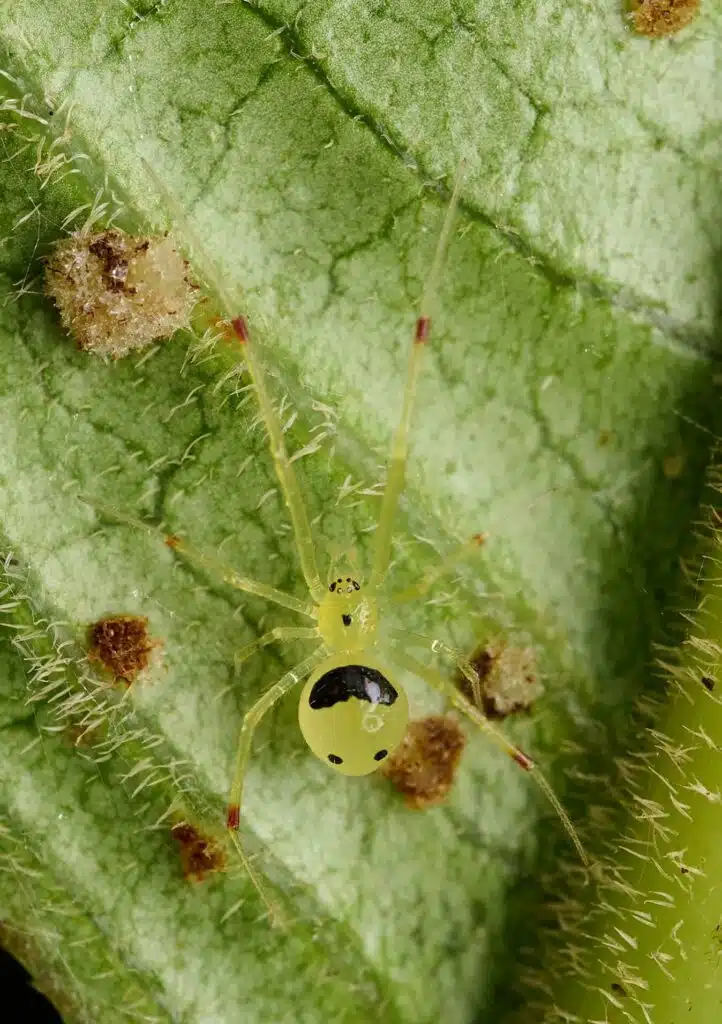
Hawaiian Happy-face Spiders (Theridion grallator) are among the few bugs in the world to have a smiley face. There’s a clearly-distinguishable smiley face on their dorsum.
Formed by joining 2 black spots like eyes with a mouth-like curved black line, this happy face of the species is clearly visible as Hawaiian Happy-face Spiders are green.
These spiders have a translucent green color which means the contrast of the black face is even higher.
Growing to an expected size of 0.19 inches, this is a small spider that lives on leaves where its ground green color may make it more difficult to spot.
It only lives in some of the higher-humidity areas of Hawaiian forests.
9. Dark Fishing Spider

These dark-looking spiders (Dolomedes tenebrosus) are some of the most atypical types of spiders when it comes to their feeding habits.
Perfectly adapted to walking on water, Dark Fishing Spiders move onto the water to catch and eat small fish.
Not all spiders build spider webs to trap all types of insects. Some simply move on to water to catch their next meal.
Dark Fishing Spiders achieve these due to the hairs covering their legs, which trap small air bubbles which allow them to float.
However, these types of spiders only consider shallow water such as the edges of small streams and rivers as this is where the water is clear and where they can spot the small fish passing by.
They can be seen floating on water and identified by their dark brown, black, and often striped appearance.
10. Goliath birdeater
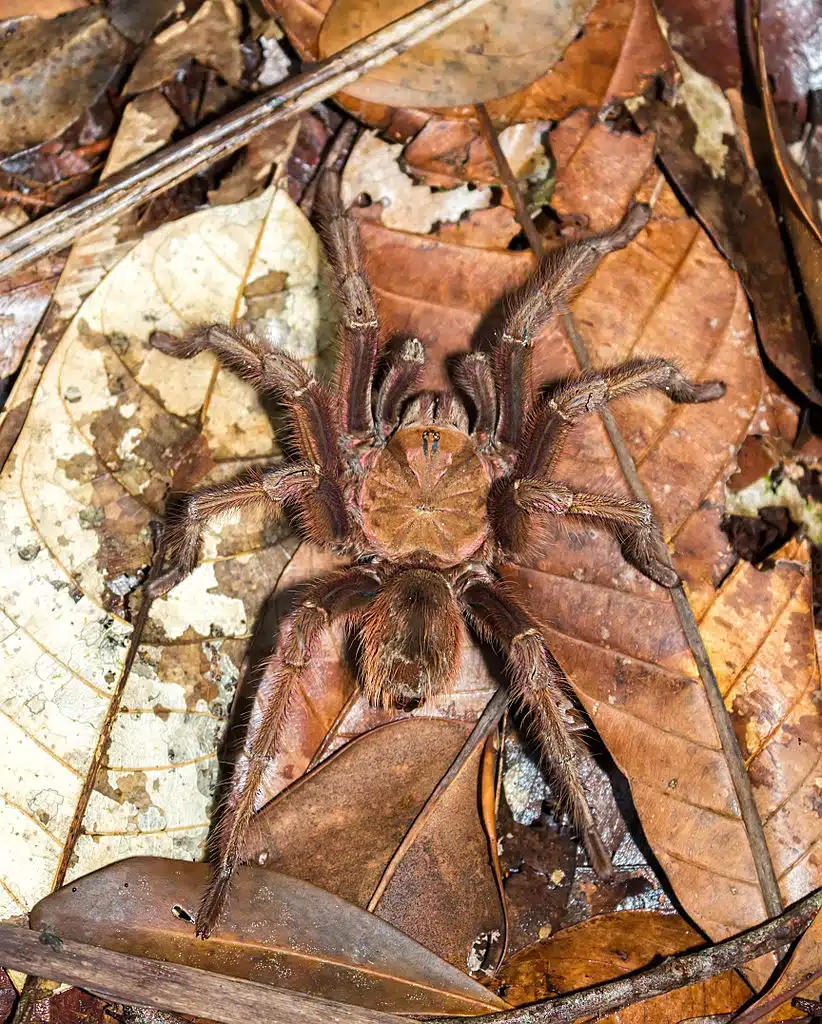
A species of South America, Goliath birdeaters (Theraphosa blondi) are known to sometimes strike small birds.
This is one of the largest spiders in the world, often even reaching a size of up to 12 inches.
Native to the forests of countries such as Suriname or The Guyanas, this is a spider with a large appetite and mouthparts to deal with large prey.
It still prefers bugs and insects, as well as other types of spiders as quick meals.
Given the chance, Goliath birdeaters don’t back down from grasping a bird.
These spiders have been spotted eating hummingbirds. In fact, a hummingbird-eating spider drawing is the first written evidence of the species which has led to its official name.
11. Bombardier Beetles
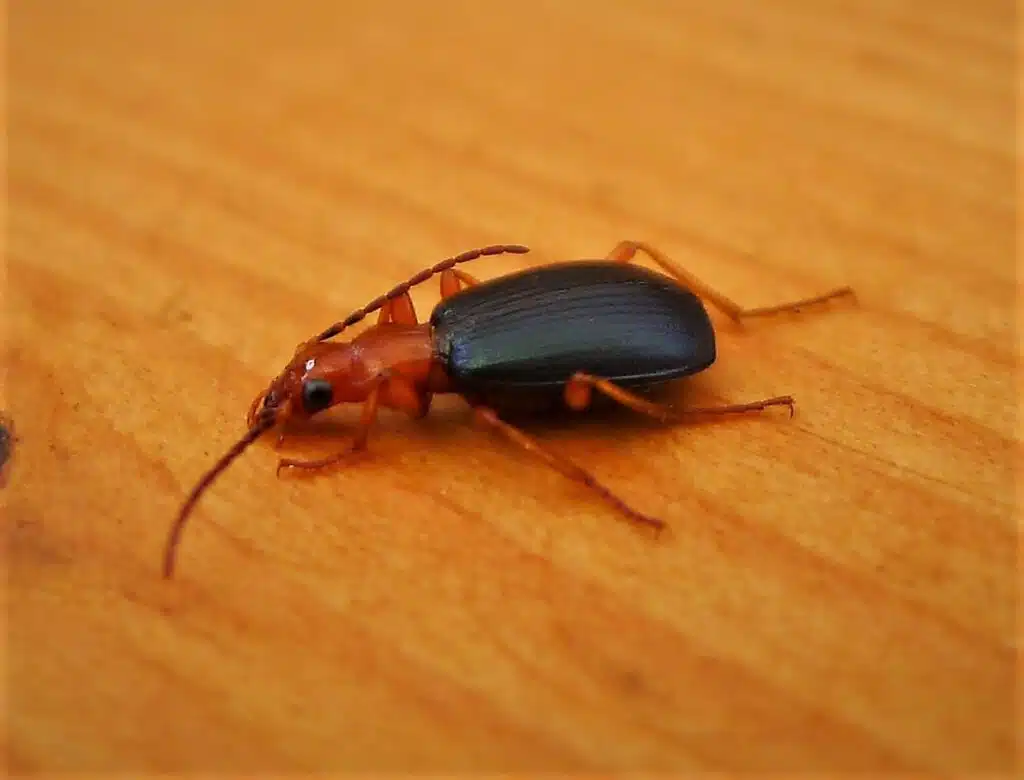
Mostly black and brown, Bombardier Beetles (family Carabidae) are named after their capacity to spray chemicals onto their enemies.
Nobody knows exactly why these bugs can produce strong chemicals, but it is believed to be a self-defense adaptation.
This is why Bombardier Beetles only spray chemicals when disturbed. This prompts some of their common predators in woodlands to spit them out and move on.
This type of bug is found all around the world. Its diet allows it to absorb toxins and process them as chemical sprays that can be released from its rear end.
While highly common, Bombardier Beetles may not be easily spotted during the day as they are exclusively nocturnal.
12. Frog-legged Leaf Beetle
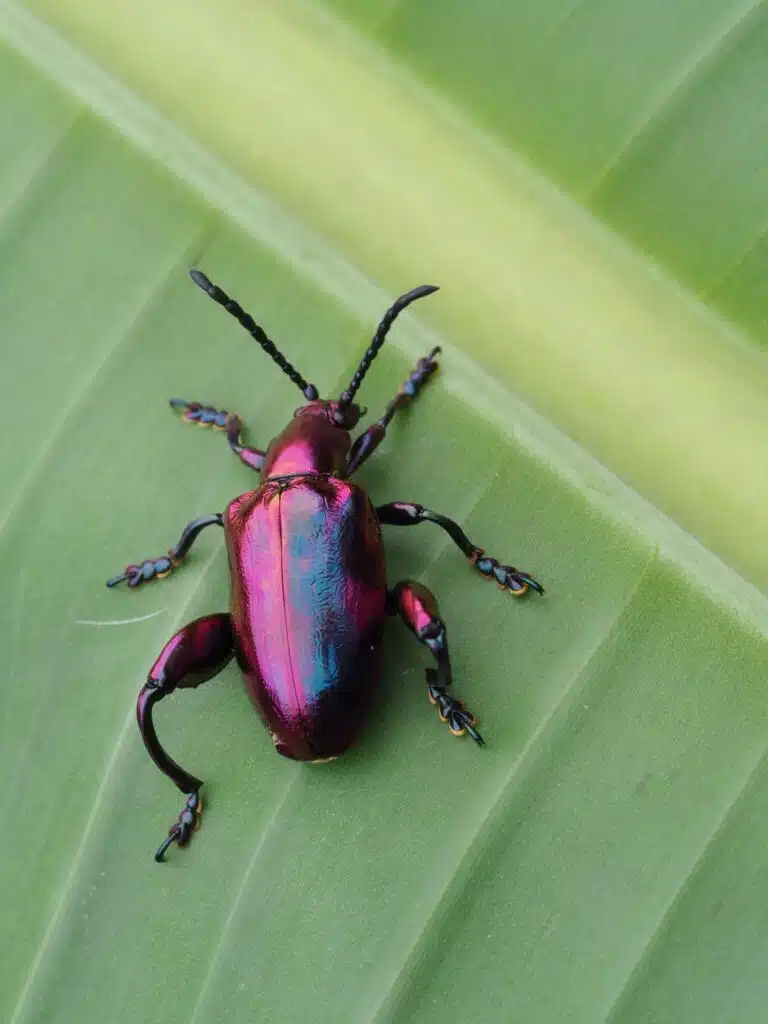
The shape of the elongated hindlegs of these bugs (Sagra femorata) inspires their name.
Some of the weirdest colors in the world of bugs are also specific to the species.
There’s some color variation within the species which includes pink, purple, and blue nuances across the body.
These are all metallic or high-sheen colors which means the bug stands out, especially in full sun.
Apart from its large hindlegs which look like the legs of a frog, The Frog-legged Leaf Beetle also comes in a multicolored morph.
This includes yellow, brown, green, and purple nuances which cover its body.
Some of the rarest morphs of these frog-like bugs also include a mostly rust and green color, a highly atypical but not unique color combination based on an iridescent look.
13. Austroplatypus incompertus
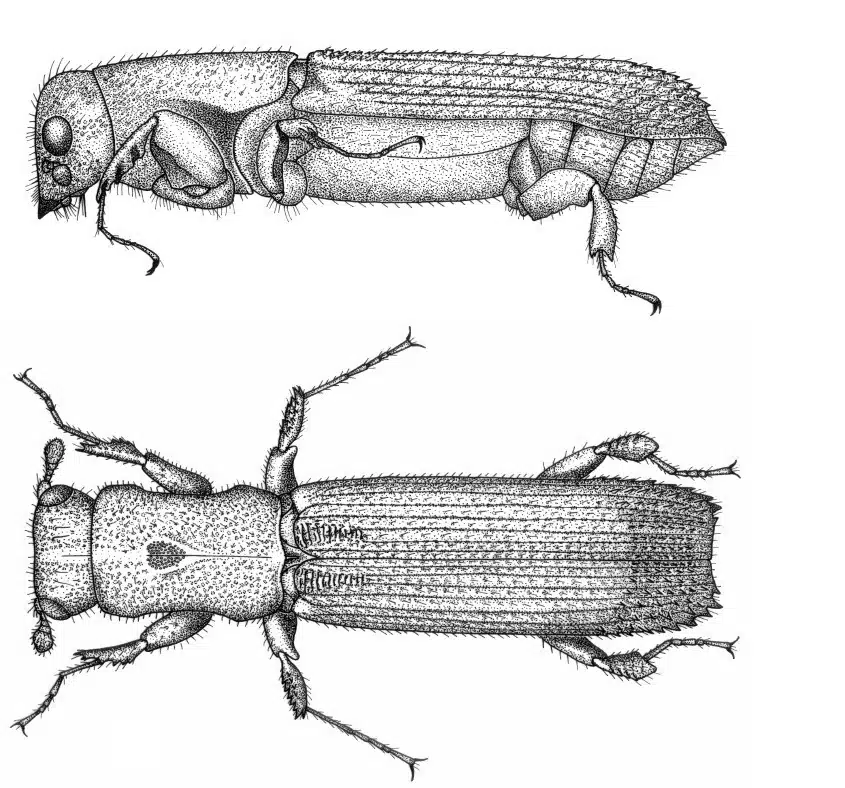
While this bug has a strange elongated squarish shape, it’s the breeding habits of the species that are really weird.
Living in groups, these eusocial bugs are dominated by a single female with the capacity to lay eggs.
All other females take care of this breeding female, much like a queen bee dominates a hive with other females offering a supportive role in their colonies.
These bugs also have distinct eating habits. They can bore in eucalyptus trees as well as in different other types of plants and flowers such as those in the ambrosia family.
It’s the dominant female that eventually bores into wood or the stems of plants to lay eggs which also hatch here.
14. Hercules Beetle

Some bugs have different means of defense while others have no self-defense capacity.
As far as self-defense and even aggression go, Hercules Beetles (Dynastes hercules) always come up on top.
Named after their atypical strength, these bugs strangely have horns. These horns are even longer than on other bugs with horns.
There’s an upper and a lower horn projecting forward from the head of the bug.
These types of horns are used for grabbing or hitting. Hercules Beetles can even flip and toss other Hercules Beetles.
It’s typically the males of the species that are aggressive towards one another, mostly for breeding rights and territorial gain.
15. Giraffe Weevil
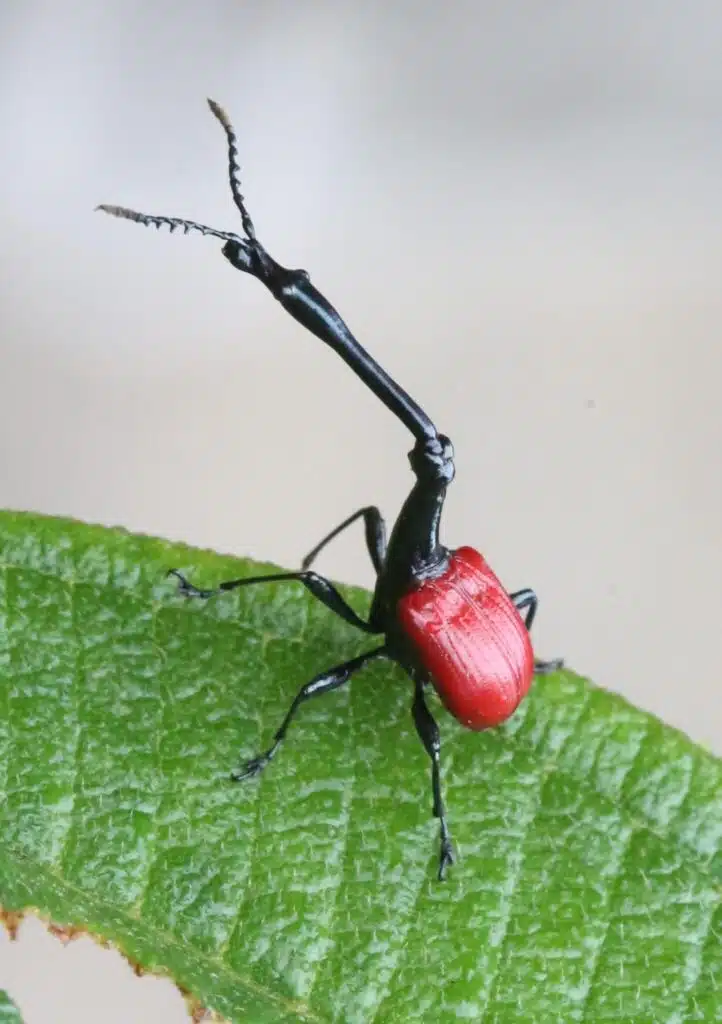
A species that lives in Africa and South Asia, Giraffe Weevils (Trachelophorus giraffa) are among the atypical bugs with long necks.
These weevils have very long necks, often up to 3 times as long as their own body.
A long black neck, a black head, and red elytra are characteristic of this leaf-roller bug.
Males have slightly longer necks as they even rely on them when fighting other males. Females of the species also have long necks that bend in the middle which they use to move leaves into a rolled position.
Giraffe Weevils grow to 2-3 inches but only males are known to fight while female weevils are mostly dependent on their long necks to manage leaves before laying eggs.
16. Vampire Moth
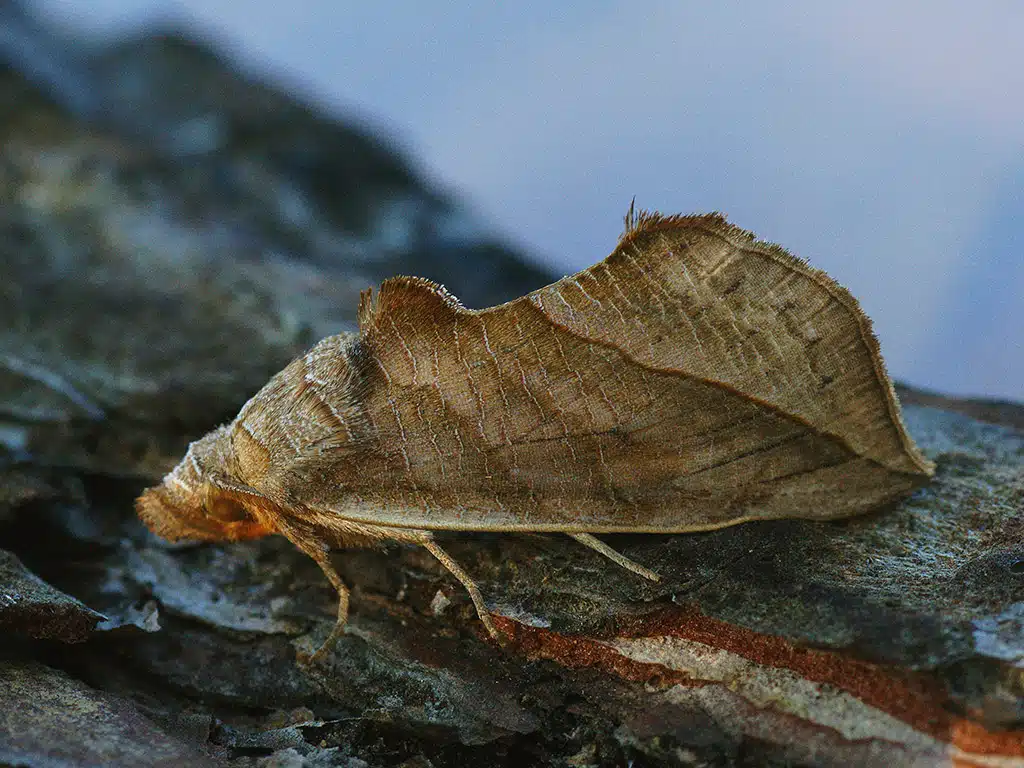
Moths can feed on plant nectar or don’t even feed at all. A small number of moths have highly atypical or weird feeding habits.
This is also the case with the blood-sucking Vampire Moth (Calyptra thalictri). This is a species that feeds on animal blood.
At least a few confirmed cases of Vampire moths drinking the blood of humans have also been confirmed.
While this type of moth can also follow humans for blood, it is still not considered a major problem or a vector for spreading disease.
Even the appearance of the species signals a potential thirst for blood as this moth has pink and red nuances across its forewings and hindwings.
17. Death’s-head hawkmoth

Yellow and friendly-looking in its caterpillar stages, Death’s-head Hawkmoths (genus Acherontia) move on to become feared adults and the subjects of myths.
There’s a distinct mark that resembles a human skull on the upper dorsum of this species.
Mostly black and yellow, this is a species with a yellow death mark on its upper body which signals a potential myth behind it.
Growing to 5 inches, this is also a large moth that has been associated with different popular beliefs over the years.
Present in Africa and Europe, Death’s-head hawkmoths are commonly found in popular culture, mainly associated with death itself or other unfortunate events.
They may only be detrimental to bees as they cover themselves up in wax to cover their scent and highjack bee hives for honey as bees don’t attack these intruders.
18. Atlas Moth
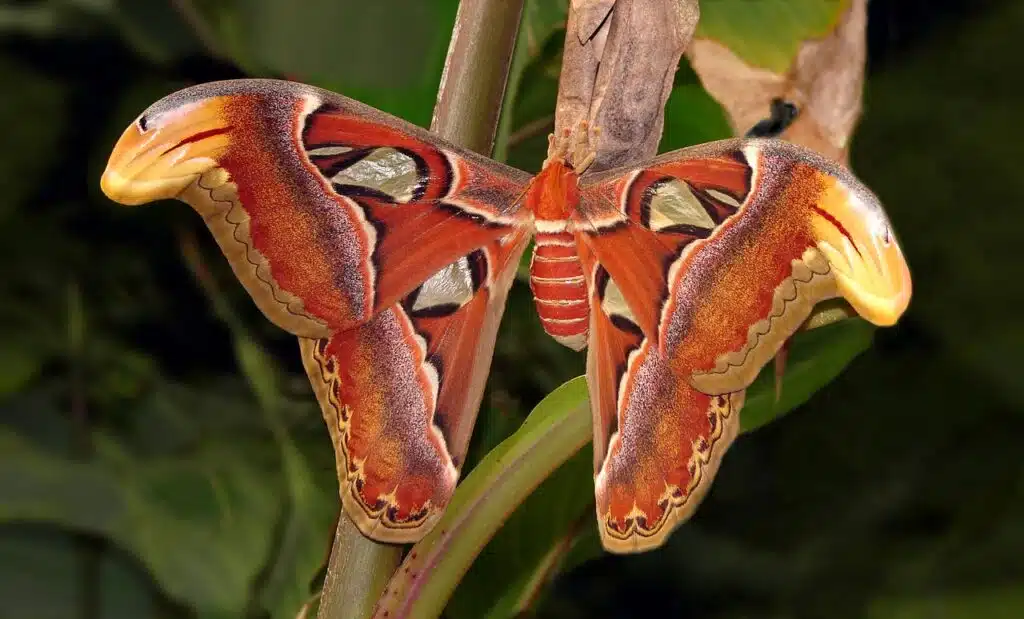
If Death’s-head hawkmoths are the largest in Great Britain, Atlas Moths (Attacus atlas) are among the largest moths in the world, with a wingspan of up to 9.4 inches.
Once adults, these moths are so large their expanded wings can be larger than a palm.
A colorful appearance is specific to this moth which is even bigger than most butterflies.
Much of its life is marked by a weird appearance and even by a head that resembles the head of a snake.
Its caterpillars, which are mostly green, are also spiked and their heads are often compared to the heads of dragons.
The appearance of Atlas Moths is inspiring arts and culture around the world. These moths are also represented on Japan Post stamps.
19. Baphomet Moth
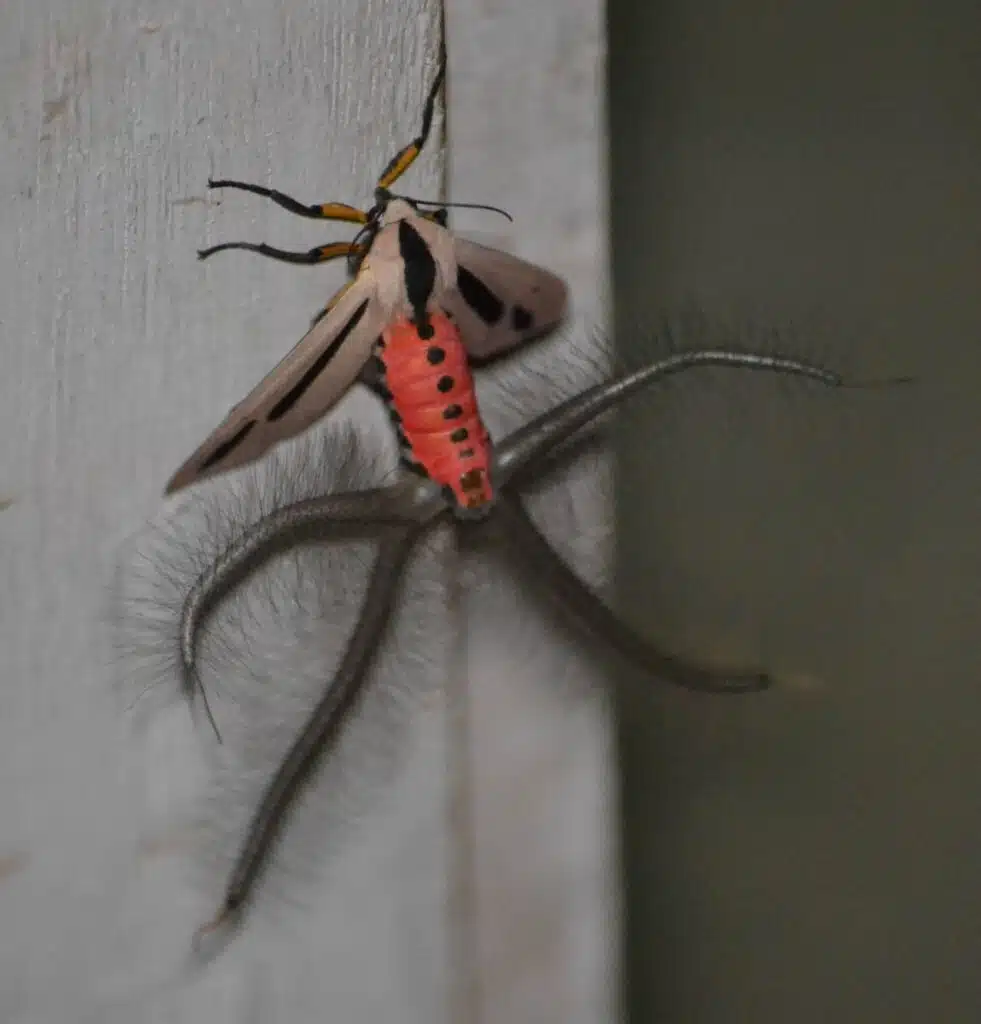
Moths may look scary in comparison to butterflies, in general. Among moths, Baphomets (Creatonotos gangis) are among the scariest out there.
There are 4 large projections at the rear end of the body which can look highly scary when it comes to an untrained eye. What are they?
These projections are actually hair pencils, or small coremata which are used to signal females with pheromones. Covered in shorter hairs themselves, they are only seen on the rear end of male moths.
Otherwise, Baphomet Moths rely on pheromones for breeding.
The release of pheromones within the species is believed to attract a potential mate from a longer distance compared to other moths.
20. Queen Alexandra’s birdwing
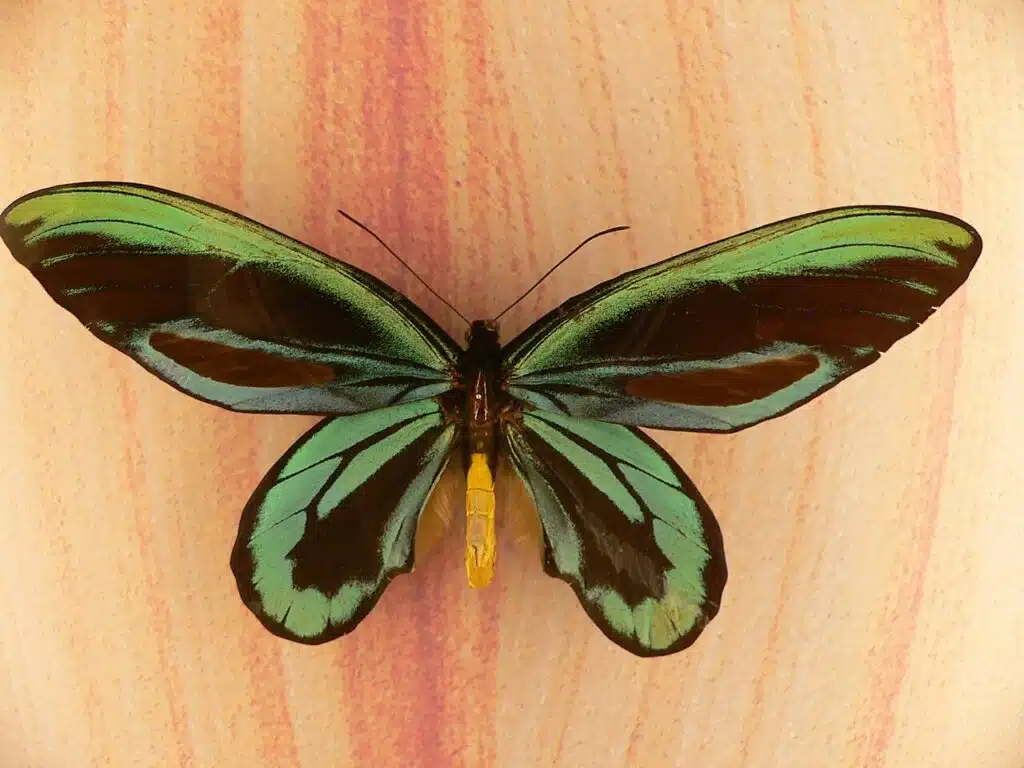
Queen Alexandra’s birdwing butterflies (Ornithoptera alexandrae) are the largest in the world. These butterflies routinely grow to a wingspan of around 10 inches and up to 11 inches.
Larger than a human hand, Queen Alexandra’s birdwings are native to Papua New Guinea.
These butterflies may be smaller, in the case of males, darker and larger in the case of females.
Blue-green colors dominate the large wings of males. The larger wings of females are mostly black and partly yellow.
Both male and female Queen Alexandra’s birdwings are partly black on the upper body and yellow on the lower abdomen.
21. Cracker Butterflies
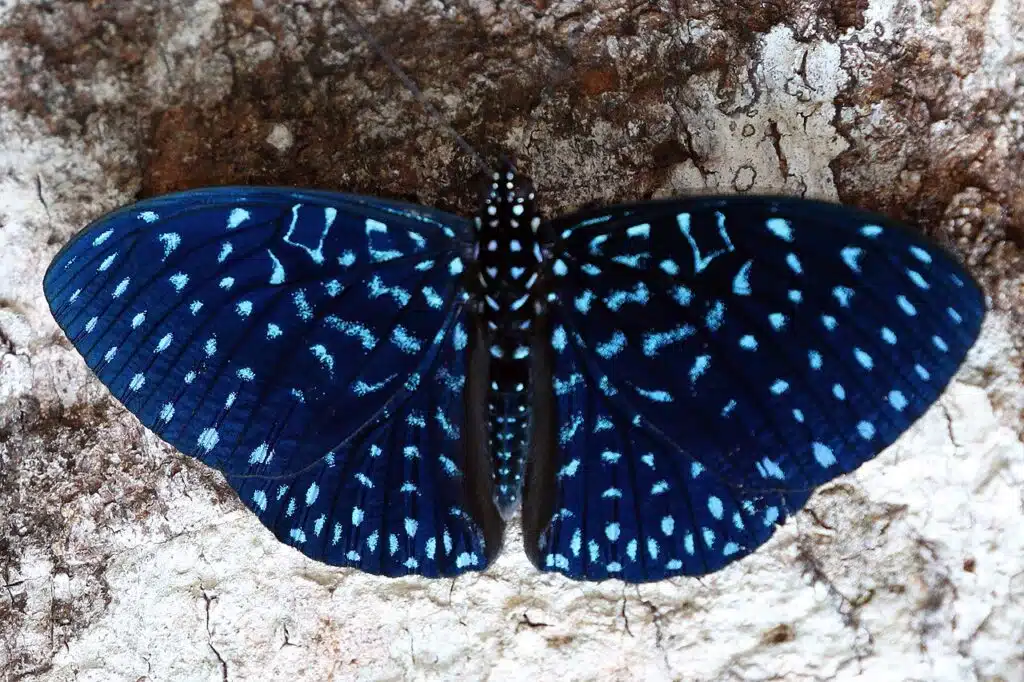
Hearing cracking noises is the last type of experience many expect with a butterfly.
However, Cracker Butterflies (genus Hamadryas) are the noisiest butterflies as they make cracking noises when they fly.
The exact purpose of these noises is up for debate. Some say these noises are specific to males which try to keep other males away.
Others say the cracking wing noises are of interest to potential female partners.
Some may also suggest there’s no real purpose behind these noises.
A large butterfly, The Cracker Butterfly is also very good at camouflaging itself. It chooses the host trees and plants which match its coloring the most.
Blue and black patterns are highly specific to males of the species.
22. Thick-tipped Greta
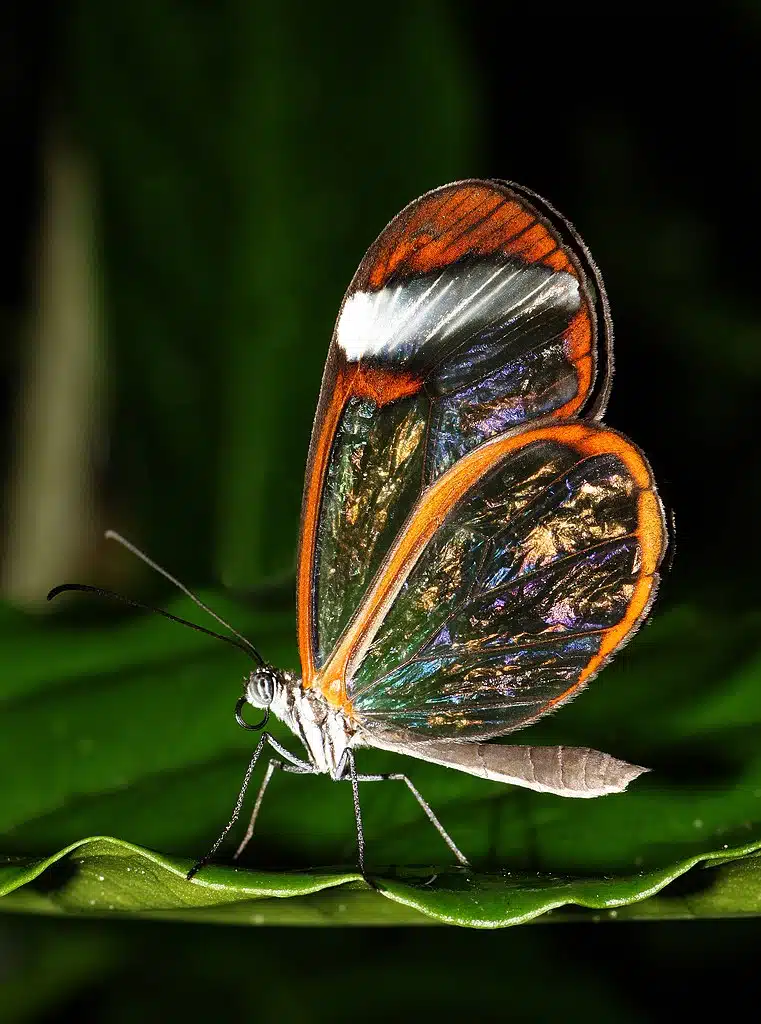
This type of butterfly (Greta morgane) is identified by its distinct transparent wings.
It only shows black and white wing tips and additional black veins together with red or brown margins.
The transparent wings are sometimes associated with its capacity to become elusive to predators which may not spot it right away.
Thick-tipped Gretas also have different types of defensive mechanisms, such as an unpalatable taste as caterpillars.
Living and feeding on deadly nightshade, Thick-tipped Greta caterpillars are avoided by predators due to the toxins they absorb from these host plants.
Unlike adults, caterpillars are colorful and not mostly transparent.
23. White Dragontail Butterfly
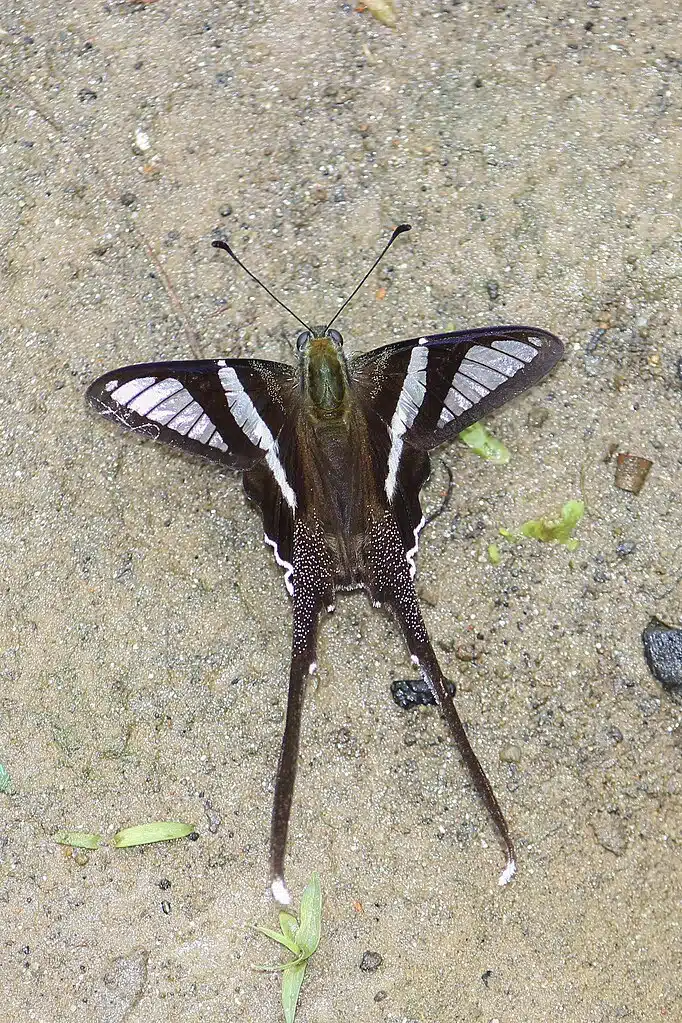
Butterflies can be spectacular by their shape, size, and colors. White Dragontail Butterflies (Lamproptera curius) are spectacular both in color and shape.
Transparent wings are known to attract the attention of those who like butterflies of this species.
A small transparent section is specific to the forewings while its hindwings aren’t transparent but mostly black and white.
This species also shows long black tails, as the official name implies. These tails are so long that they can even match the length of their wingspan.
White Dragontail Butterfly tails also stand out by having a jet black color with white tips.
The body of this large butterfly also stands out with its width and similarity to moths.
24. Jewel Caterpillar

Many caterpillars of the world have a strange appearance. This is also the case of Jewel Caterpillars (Acraga coa), a species that may actually resemble actual jewels.
A bright green base color is specific to this species which has small waxy projections and multiple orange-red dots across the body for contrast.
From some angles, and probably to some predators, these caterpillars may not even look like caterpillars at all.
Feeding on different types of plants such as those in the citrus family, Jewel Caterpillars are native to Central America.
They live in or around moist forests of Mexico, or Guatemala and they can be abundant by not necessarily truly harmful to their host trees or plants.
25. Lobster Moth Caterpillar
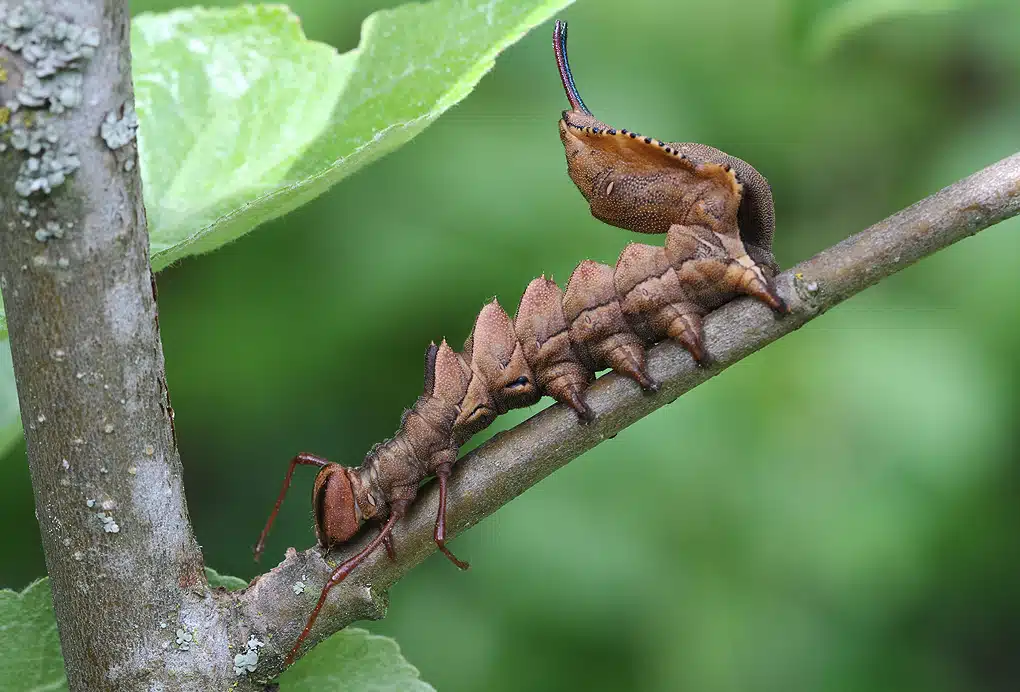
A species feeding on Acer leaves and other tree leaves, Lobster Moths Caterpillars (Stauropus fagi) have an unusual appearance.
A twisted body with long front legs and rear prolegs is specific to this type of caterpillar which tries to look dangerous to some of the wildlife that could feed on it.
This is also a species with a rear tail which almost makes it look, unlike an actual caterpillar.
Weird, twisting, and bending by nature, Lobster Moth Caterpillars pose no threat to humans but they may be a potential threat to the host trees it feeds on.
26. Daring Owl-Butterfly Caterpillar
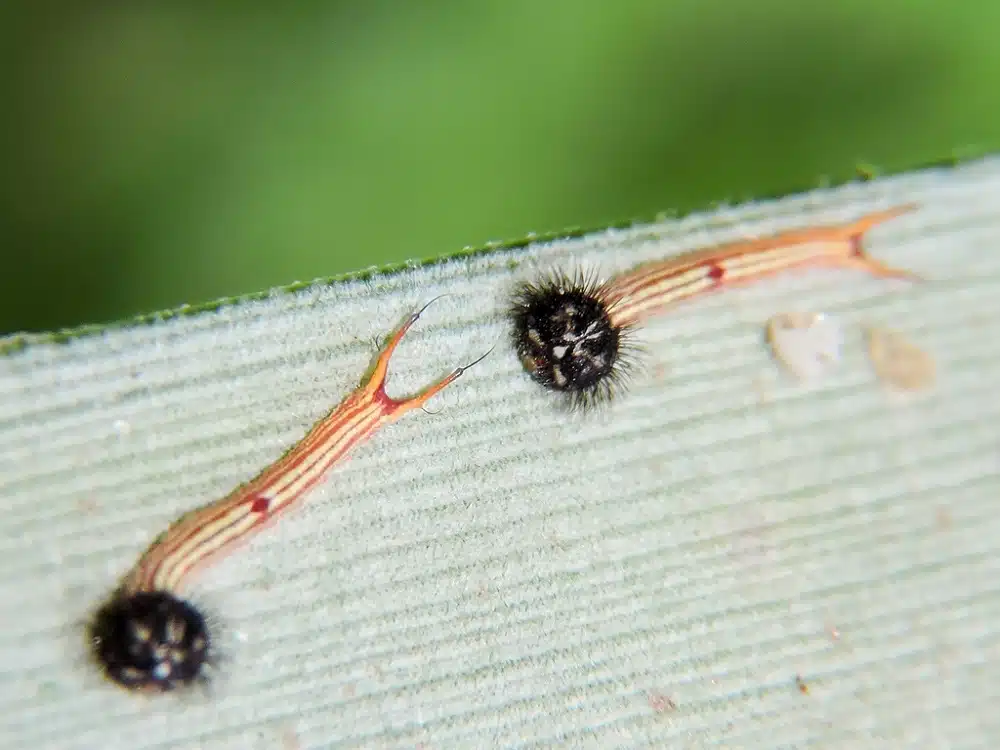
The life of The Daring Owl-Butterfly Caterpillar (Dynastor darius) is marked by a strange appearance.
In its first instar or in its early days, this is a caterpillar that even looks like a snake.
It takes on the shape and color of the head of the snake.
As it grows, this caterpillar becomes green but maybe even weirder. It shows a black head with a brown face and additional black horns.
The first stages and intermediate stages are also weird stages for this caterpillar.
In its intermediate stages, this caterpillar is mostly black and white but it features a hairy-looking black head which may make it look dangerous to predators.
These black hairs eventually turn to black horns, an atypical look for caterpillars.
27. Saddleback Caterpillar

A spiny body makes The Saddleback Caterpillar (Acharia stimulea) look, unlike a caterpillar.
Its spiny appearance is based on multiple long projections at the ends of its body with an additional saddle-like pattern on the dorsum.
Multiple smaller spines cover its large spines, making this species one of the most dangerous-looking caterpillars.
Apart from keeping predators away, its spines can actually protect it from predators that may spit it out.
In addition, this caterpillar may also take on a saddleback color that matches the color of its environment.
28. Jack Jumper Ant

Jack Jumper Ants (Myrmecia pilosula) can jump high! These types of ants are ready to take a long leap, often a few times the size of their body for the next meal or to escape from a dangerous situation.
Known to jump on prey, these predatory ants feed on small insects.
Native to the forest in Southern Australia, Jack Jumper ants are also venomous and can bite.
The painful bites of the species are mostly used against small prey. Insects are quickly overpowered when venom is injected with the first bite.
While not foraging ants, Jack Jumper Ants are still led by a queen of the colony.
The role of the queen is considerably reduced in the species compared to other nesting ants.
29. Common Giant Turtle Ant
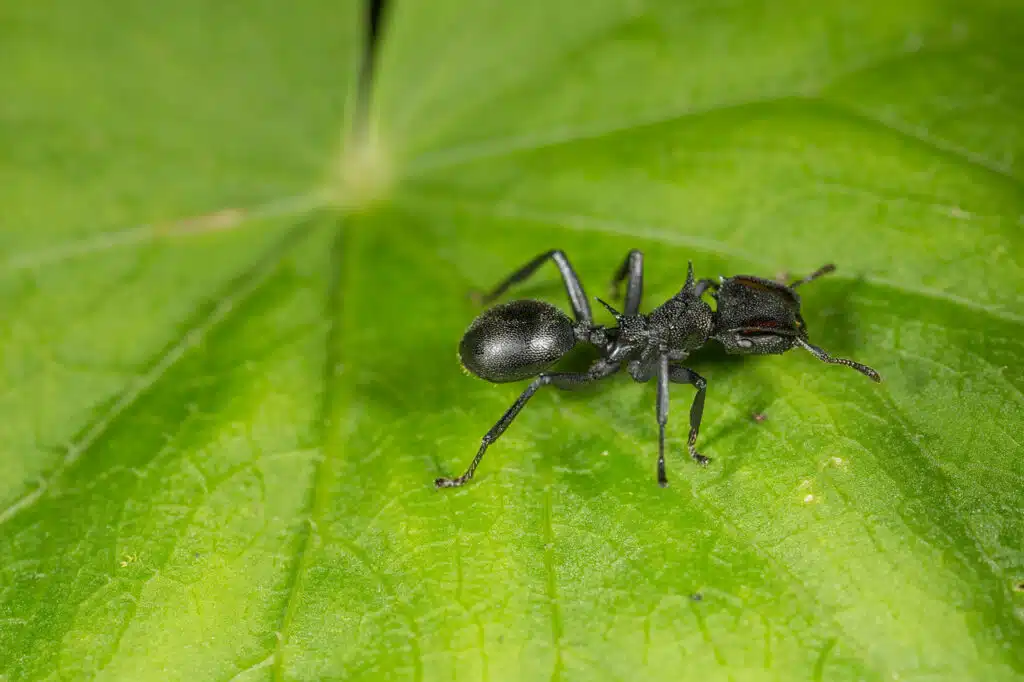
Some of the ants in South America come in different odd shapes. This is also the case with the rather large Common Giant Turtle Ant (Cephalotes atratus) and its shape.
First, this is a species that grows to a size of up to 0.6 inches, which even compares the ant to species of bugs per size alone.
Then, the species stands out with its odd head. An enlarged head compared to the size of its body is seen in these ants.
Thirdly, worker Common Giant Turtle Ants have multiple spines, used as a means of defense.
Native to Brazilian forests, this is one of the largest types of ants in South America and the world.
30. Saharan Silver Ant

Living in The Saharan Desert is almost impossible for most species of ants, but not for the Saharan Silver Ant (Cataglyphis bombycina).
This adaptable high-speed species can reach a top speed of 1.9 miles per hour!
While it doesn’t sound much to humans, the top speed of these ants allows them to cover a distance of almost 100 times their body size each second!
Ready to run fast to avoid spending too much time out in the sun, Saharan Silver Ants typically run towards carcasses that they feed on to then quickly run back to their nests.
To achieve this impressive speed for ants, they even lift their front legs to shift their weight balance back and to move fewer legs.
31. Metallic Bluish-green Cuckoo Wasp

Wasps are mostly associated with black and white or black and yellow color patterns.
This isn’t to say there aren’t any other types of wasps. Just look at the blue-green Metallic Bluish-green Cuckoo Wasp (Chrysis angolensis).
As their name implies, these wasps have a metallic appearance which makes them stand out in the sun.
Both blue and green metallic nuances morph on its body and wings.
By some sources, the colors are the result of environmental adaptions while others note these wasps tend to look a bit off-putting to potential predators based on their metallic nuances.
32. Steel-blue Cricket-hunter Wasp

The blue color of this wasp is so prevalent it inspires its name. Steel-blue Cricket-hunter Wasps (Chlorion aerarium) are known for their dark blue nuance.
Unlike most types of wasps, The Steel-blue Cricket-hunter Wasp is a species that only feature one major dominant color with additional black wings and legs.
The metallic nuance of this wasp is a characteristic of iridescent coloring. Wasps of the genus impress with their predatory skills as well.
While not relying on their color for camouflage, female Stee-blue Cricket-hunter Wasps hunt crickets which they paralyze and use as a long-term food source for the emerging larvae of the species.
33. Wallace’s Giant Bee

Wallace’s Giant Bees (Megachile pluto) are considered the largest in the world. These bees have a wingspan of up to 2.5 inches!
This is almost 3 times the length of The Western Honey Bee.
Native to Indonesia, these types of bees are a rare sight, on the other hand. There are some of the weirdest rare bugs in the world as they only occur on 3 islands of Indonesia.
Long believed to be extinct, these bees still live in remote areas in small numbers.
Having long mandibles is another interesting fact regarding Wallace’s Giant Bees. However, only the female bees have elongated mandibles.
Once believed to be extinct decades ago, this bee was sold on eBay for $10.000 each due to its scarcity.
34. Vulture bees
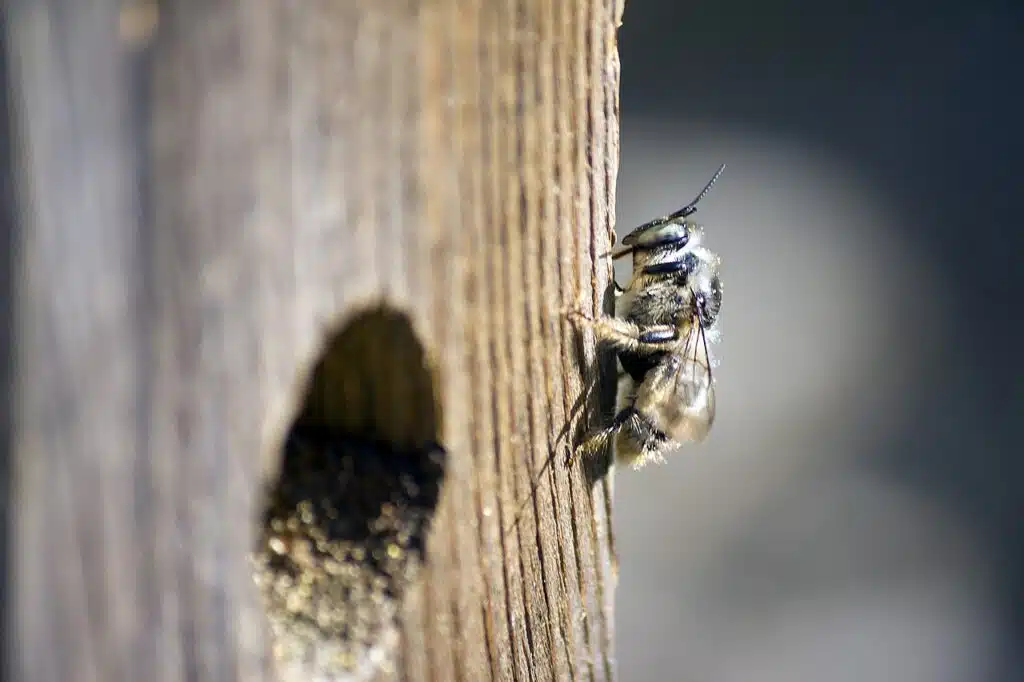
You often imagine bees on plants and flowers, visiting many of them for pollen.
Vulture bees aren’t interested in pollen but meat, specifically carrion!
These types of atypical bees are known for eating different types of meat. To make things even more complicated, it seems like Vulture bees even store meat which they carry back to their hives, much like honey bees carry pollen.
Scientists also inform the honey made by Vulture Bees is still edible and sweet-tasting.
Long studied for their weird feeding habits, Vulture Bees are known for properly digesting meats.
Their stomach has a specific acid that helps break down meat, an acid that isn’t present in most other types of pollen-eating bees.
This type of gut bacteria is also found in humans. It has been tied to beneficial gut bacteria which humans rely on for digesting foods that are fermented.
35. Indian Domino Cockroach

One of the most atypical types of cockroaches in the world is the black and white Indian Domino Cockroach (Therea petiveriana).
This is a mostly black cockroach with a few white spots on the elytra.
Mostly found in forests, this is a species believed to mimic other black bugs with white dots such as The Six-spot Ground Beetle.
Known for its round shape and slightly dome-shaped elytra, The Indian Domino Cockroach almost looks like a ladybug as opposed to looking similar to roaches.
This bug further stands out with a capacity to spray chemicals onto its opponents, also believed to be a mimicry tactic.
These bugs and their eggs are spotted in the morning among the ground-level leaves in Indian forests.
36. Spider Crickets
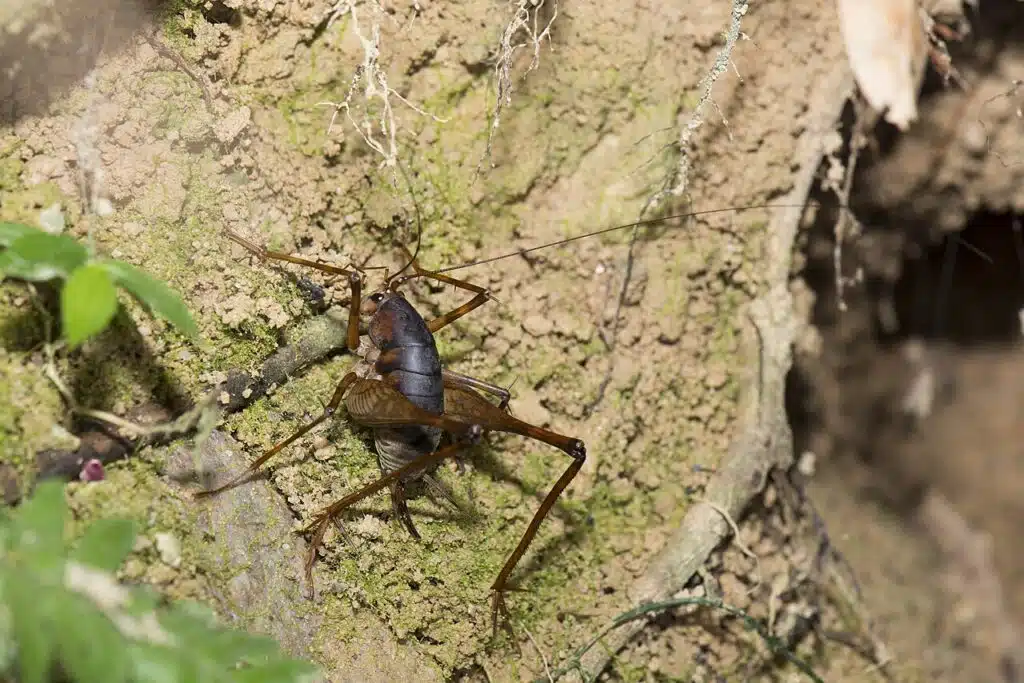
These types of crickets (family Rhaphidophoridae) are very atypical in habitat choices.
Also known as Cave Crickets, Spider Crickets live in some of the darkest caves in Asia, Europe, and North America.
This is a cricket that also lives in other moist areas such as in woodlands where it finds its way under dead trees and logs.
Cricket is known for having strong and long rear legs and for having the capacity to jump.
It may accidentally enter homes in some areas of the world, but it doesn’t establish itself as a pest.
Spider Crickets may attract other predatory bugs in the house, in case they establish themselves indoors in areas such as the basement.
While it may seem rare due to living in caves and due to being mostly nocturnal, Spider Crickets live in hundreds of species around the world.
37. Rainbow Grasshopper

Found in the Southern and Southwestern United States, Rainbow Grasshoppers (Dactylotum bicolor) have a multicolored appearance.
Unlike most other types of grasshoppers, these bugs come in red, green, yellow, and black color patterns.
Their colorful nature may match their vegetation-rich habitat.
These types of grasshoppers also come in different other types of patterns such as black and red, or black, red, blue, and green.
There’s even a pink, black, and yellow Rainbow grasshopper.
Easily spotted in their areas in the Southern parts of North America and Mexico, these bugs feed on different plants.
Still, they only live in areas with plenty of False Willow as this is the sole plant their young feed on.
38. Spiny Devil Katydid

Katydids are some of the most common green bugs in the world.
Spiny Devil Katydids (Panacanthus cuspidatus) are an uncommon variation, on the other hand. This is a species with spiny legs and a spiny body.
Short green spines cover the body while most spines are yellow or brown and seen across its legs.
There is even a short bung of orange spines on the top of its head.
One of the theories behind these spines is that these katydids try to hide from predators by looking more like plants and twigs.
Other theories argue the spines are meant to act as early warning signs for predators to stay away.
These types of katydids are also some of the oldest bugs in the world believed to communicate through sound waves.
39. Orchid Mantis
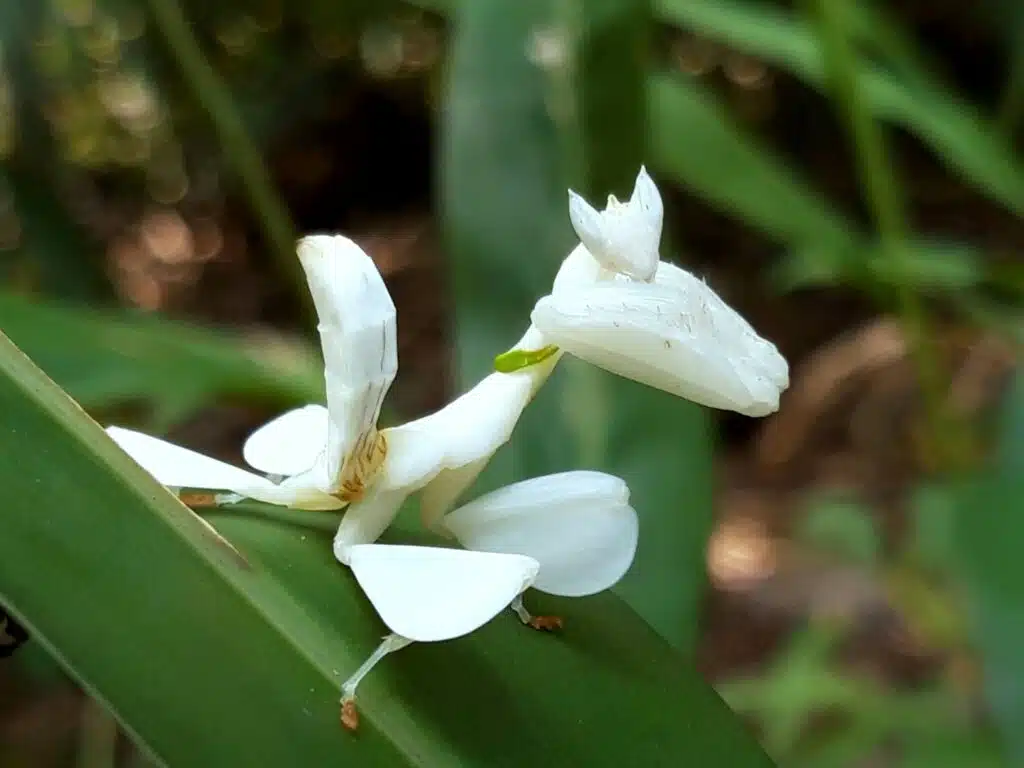
Praying Mantises are mostly believed to be green but there are many exceptions, Orchid Mantis (Hymenopus coronatus) included.
This is a type of mantis that matches the color of its host flowers.
As a result, it takes on white, pink, salmon, or bright red nuances. Unlike most other mantises, The Orchid Mantis is very bright and camouflaging.
This means most types of pollen-eating insects approach the bug and the flower it lives on without detecting it.
Orchid Mantises manage to grab these pollen-eating insects with their raptorial front legs.
These bugs are also very fast, which allows them to postpone their attack until the last moment.
Orchid Mantises are a common sight in tropical and subtropical Asian climates.
40. Common Ghost Mantis
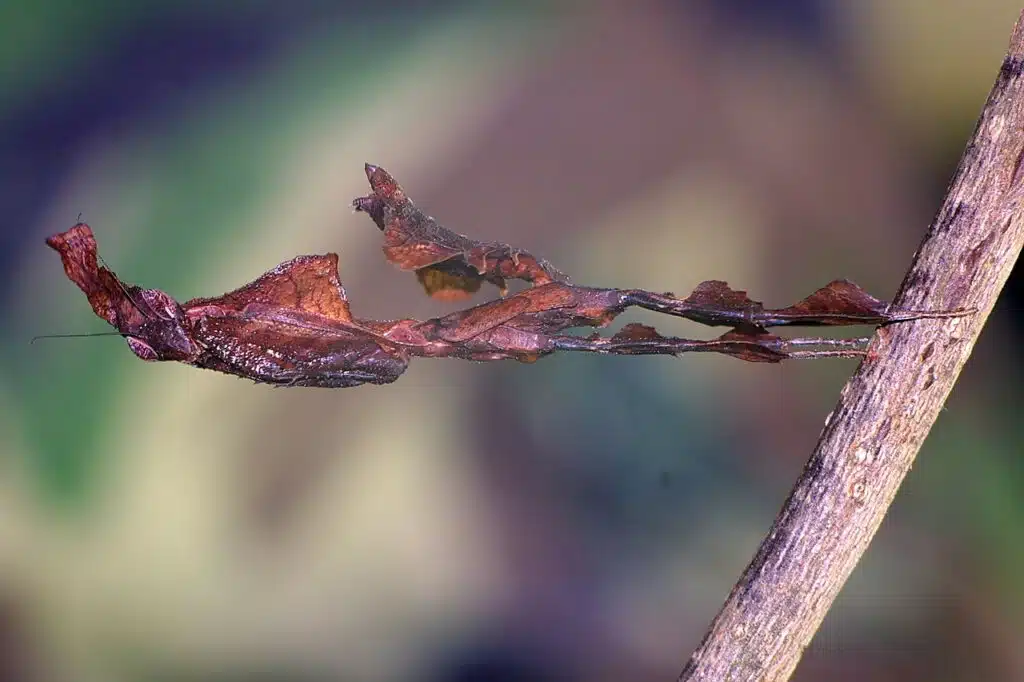
Even more unusual than The Orchid Mantis, Common Ghost Mantises (Phyllocrania paradoxa) take on the appearance of thin dry leaves.
They mimic dead leaves so good they often get overlooked and may not be spotted even on humans when resting among dead leaves or dying leaves.
African natives, these mantises are known for their high number presence in countries such as The Ivory Coast.
They are among the bugs that live in shrubland, small bushes, and in other areas with at least some vegetation.
The type of vegetation they live around also impacts their final appearance.
While the general color of these bugs is brown, they come in different shades. This includes tan, red-brown, and dark brown.
From bright to dark, these types of bugs may also mimic dying leaves in their different stages by color and shape.
The head, body, and even legs are also shaped like leaves.
41. Wind Scorpions
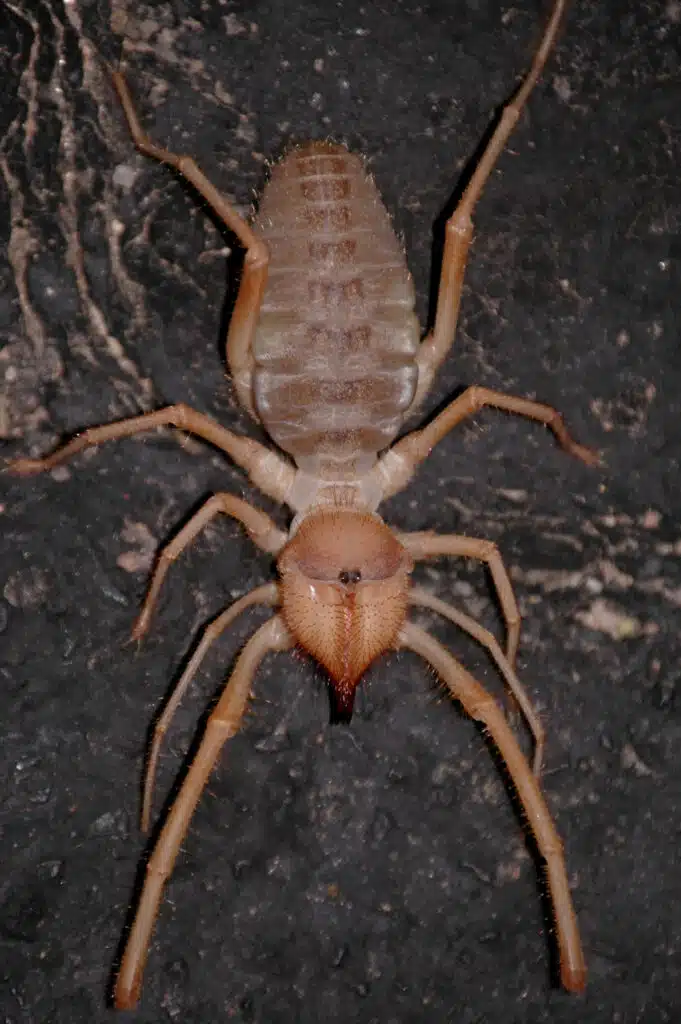
Wind Scorpions (order Solifugae) are types of solifugae. These creatures look like very large spiders and are subject to different types of myths.
The movements of their mouthparts and their large size allow Wind Scorpions to eat all types of food, including scorpions, albeit, on rare occasions.
Wind Scorpions rely on very good vision to notice their next insect meal.
They grow to a size of up to 6 inches, but most are 2-4 inches long.
Wind Scorpions were believed to be highly dangerous to humans, but they don’t attack humans.
In fact, it was humans who used to stage fights between Wind Scorpions and other species due to their spectacular appearance and large size.
Wind Scorpions also live in the wilderness today, under different species. They mostly feed on ants, termites, and bugs.
42. Pseudoscorpions
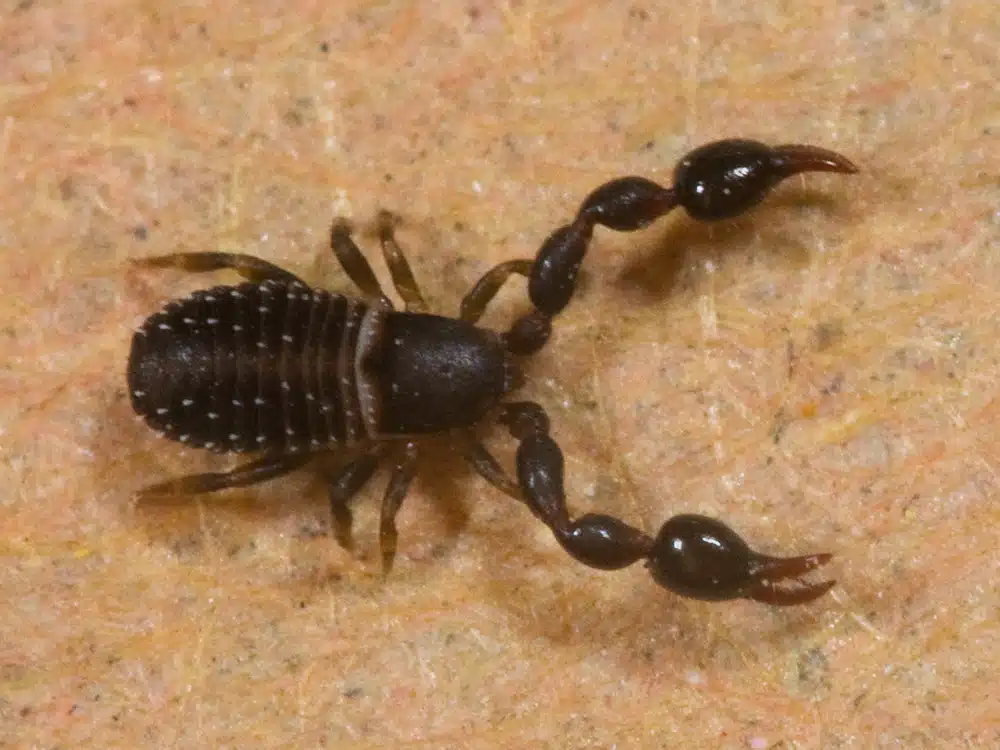
If Wind Scorpions were used in staged fights with scorpions, Pseudoscorpions used to be confused with actual venomous scorpions.
Pseudoscorpions are types of arachnids also known as False Scorpions.
They are given this nickname based on their front raptorial legs which resemble scorpions and their pincers.
Known for having long front pedipalps, pseudoscorpions are small and easy to distinguish from actual scorpions.
An actual scorpion has a tail and grows to several inches while most pseudoscorpions grow to a size of up to 0.3 inches.
This small size means these types of bugs may also be taken as other types of bugs, including ticks as they go through their red-brown phase.
43. Whip Spiders

Whip Spiders (Amblypygi sp.) are some of the most atypical types of spiders by appearance.
These spiders have 8 legs but only use 6 of them as 2 legs are actually used for detecting terrains rather than for walking.
Long legs on the species may even resemble small whips.
Whip Spiders also have their legs arranged in a crab-like fashion. This means they even walk like small crabs.
These types of bugs can be raised in enclosures as pests. You need large enclosures and grass with additional vegetation for them to thrive indoors.
44. Vinegaroons

Elongated arachnids that grow to several inches, these native Southern US bugs are types of bugs that look like scorpions.
They feature long front legs and a dark brown to black color in many situations.
Found in Southern and Southwestern US deserts, Vinegaroons also have very long and pointy antennae.
While abundant in deserts, these arachnids only come out at night. You may still not easily find them as Vinegaroons don’t travel much.
They practice a sit-and-wait tactic when it comes to finding their next meal.
45. Dobsonflies
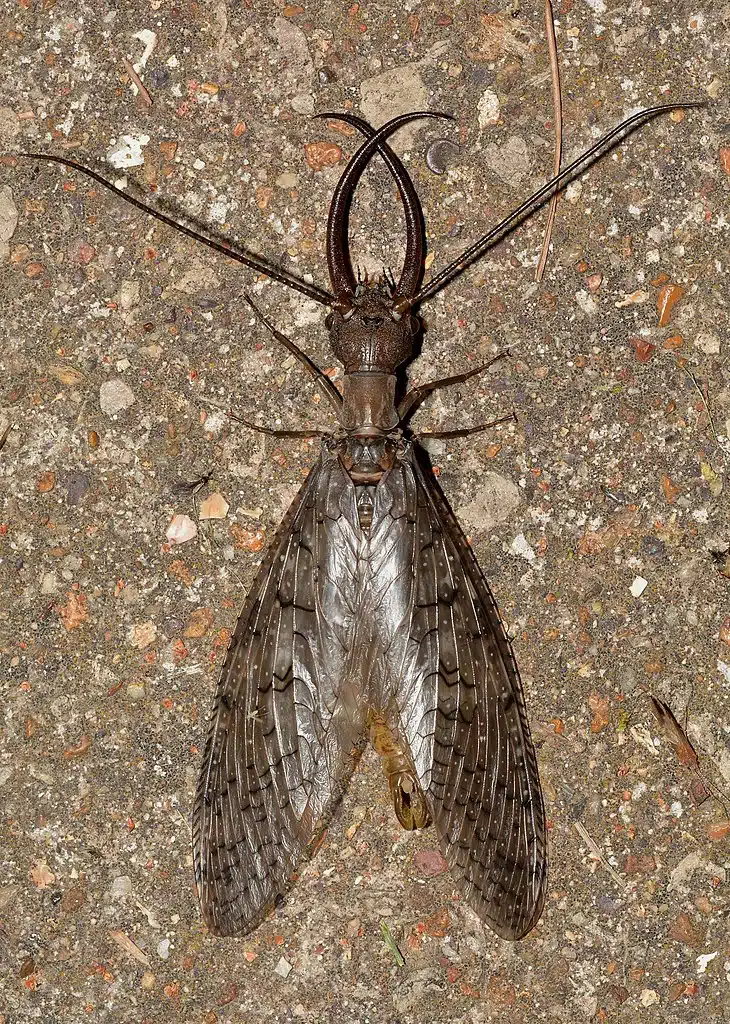
Dobsonflies (family Corydalinae) are some of the weirdest types of flies by their looks and behavior.
They can be large, often growing to a few inches and having wings as long as a palm.
These types of flies also have long mandibles which allows them to easily catch prey even in some of the unlikeliest conditions.
One of these conditions includes shallow water, areas where Dobsonflies wait for their next prey.
These flies only hunt at night, coming out next to water and taking advantage of shallow waters to quickly trap young bugs on the water such as mayflies.